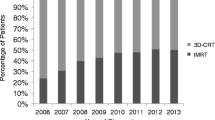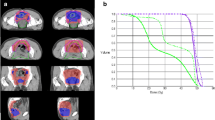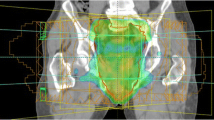Abstract
Objectives
Three-dimensional conformal radiotherapy (3DCRT) and intensity-modulated radiotherapy (IMRT) are both utilized in rectal cancer treatment. We investigated the impact of demographic and clinical factors for the selection of each modality utilizing the National Cancer Database.
Methods
Adult patients with stage II and stage III adenocarcinoma of the rectum diagnosed from 2004 to 2013 were included. Chi-squared analysis was used to compare demographic and clinical variables in the 3DCRT and IMRT treatment groups. Univariate and multivariate logistic regression modeling was used to identify factors predictive of receipt of each radiation therapy (RT) modality.
Results
A total of 9027 patients were identified: 8141 in the neoadjuvant RT group and 886 in the adjuvant RT group. In both cohorts, the utilization of IMRT increased over the study period (p < 0.01). Factors predictive of receiving IMRT on multivariate analysis include non-white race (OR 1.28, 95 % CI 1.12–1.48 for neoadjuvant RT, OR 1.72, 95 % CI 1.08–2.72 for adjuvant RT) and West, Northeast, and South geographic regions. Other factors predictive of receiving IMRT in the neoadjuvant setting include treatment at an academic institution (OR 1.15, 95 % CI 1.03–1.28) and radiation dose >5400 centigray (cGy) (OR 2.07, 95 % CI 1.69–2.53).
Conclusions
The use of IMRT for locally advanced rectal cancer is increasing and surpassed 3DCRT as the most common radiation modality at the beginning of 2010. Intensity-modulated radiotherapy was given more commonly for adjuvant treatment than for neoadjuvant treatment and was associated with higher RT doses and treatment at an academic institution in the neoadjuvant setting.


Similar content being viewed by others
References
Siegel RL, Miller KD, Jemal A (2016) Cancer statistics, 2016. CA Cancer J Clin 66:7–30. doi:10.3322/caac.21332
Gastrointestinal Tumor Study Group (1985) Prolongation of the disease-free interval in surgically treated rectal carcinoma. N Engl J Med 312:1465–1472. doi:10.1056/NEJM198506063122301
Douglass HO, Moertel CG, Mayer RJ et al (1986) Survival after postoperative combination treatment of rectal cancer. N Engl J Med 315:1294–1295. doi:10.1056/NEJM198611133152014
Krook JE, Moertel CG, Gunderson LL et al (1991) Effective surgical adjuvant therapy for high-risk rectal carcinoma. N Engl J Med 324:709–715. doi:10.1056/NEJM199103143241101
Sauer R, Becker H, Hohenberger W et al (2004) Preoperative versus postoperative chemoradiotherapy for rectal cancer. N Engl J Med 351:1731–1740. doi:10.1056/NEJMoa040694
Mell LK, Mehrotra AK, Mundt AJ (2005) Intensity-modulated radiation therapy use in the U.S., 2004. Cancer 104:1296–1303. doi:10.1002/cncr.21284
Elliott SP, Adejoro OO, Konety BR, Jarosek SL, Dusenbery KE, Virnig BA (2012) Intensity modulated radiation therapy replaces 3-dimensional conformal radiotherapy as prostate cancer treatment. J Urol 187:1253–1258. doi:10.1016/j.juro.2011.11.088
Smith BD, Pan I-W, Shih Y-CT et al (2011) Adoption of intensity-modulated radiation therapy for breast cancer in the United States. J Natl Cancer Inst 103:798–809. doi:10.1093/jnci/djr100
Gill BS, Lin JF, Krivak TC et al (2014) National Cancer Data Base analysis of radiation therapy consolidation modality for cervical cancer: the impact of new technological advancements. Int J Radiat Oncol 90:1083–1090. doi:10.1016/j.ijrobp.2014.07.017
Chen Y-D, Feng J, Fang T, Yang M, Qiu X-G, Jiang T (2013) Effect of intensity-modulated radiotherapy versus three-dimensional conformal radiotherapy on clinical outcomes in patients with glioblastoma multiforme. Chin Med J 126:2320–2324
Chuong MD, Freilich JM, Hoffe SE et al (2013) Intensity-modulated radiation therapy vs. 3D conformal radiation therapy for squamous cell carcinoma of the anal canal. Gastrointest Cancer Res GCR 6:39–45
Lambrecht M, Nevens D, Nuyts S (2013) Intensity-modulated radiotherapy vs. parotid-sparing 3D conformal radiotherapy. Effect on outcome and toxicity in locally advanced head and neck cancer. Strahlenther Onkol Organ Dtsch Röntgenges Al 189:223–229. doi:10.1007/s00066-012-0289-7
Hsia T-C, Tu C-Y, Chen H-J et al (2014) A population-based study of primary chemoradiotherapy in clinical stage III non-small cell lung cancer: intensity-modulated radiotherapy versus 3D conformal radiotherapy. Anticancer Res 34:5175–5180
Freilich J, Hoffe SE, Almhanna K et al (2015) Comparative outcomes for three-dimensional conformal versus intensity-modulated radiation therapy for esophageal cancer. Dis Esophagus Off J Int Soc Dis Esophagus ISDE 28:352–357. doi:10.1111/dote.12203
Liu G-FF, Bair RJ, Bair E, Liauw SL, Koshy M (2014) Clinical outcomes for gastric cancer following adjuvant chemoradiation utilizing intensity modulated versus three-dimensional conformal radiotherapy. PLoS One 9:e82642. doi:10.1371/journal.pone.0082642
Combs SE, Habermehl D, Kessel K et al (2013) Intensity modulated radiotherapy as neoadjuvant chemoradiation for the treatment of patients with locally advanced pancreatic cancer. Outcome analysis and comparison with a 3D-treated patient cohort. Strahlenther Onkol Organ Dtsch Röntgenges Al 189:738–744. doi:10.1007/s00066-013-0391-5
Fang F-M, Chien C-Y, Tsai W-L et al (2008) Quality of life and survival outcome for patients with nasopharyngeal carcinoma receiving three-dimensional conformal radiotherapy vs. intensity-modulated radiotherapy-a longitudinal study. Int J Radiat Oncol Biol Phys 72:356–364. doi:10.1016/j.ijrobp.2007.12.054
Parekh A, Truong MT, Pashtan I et al (2013) Acute gastrointestinal toxicity and tumor response with preoperative intensity modulated radiation therapy for rectal cancer. Gastrointest Cancer Res GCR 6:137–143
Jabbour SK, Patel S, Herman JM et al (2012) Intensity-modulated radiation therapy for rectal carcinoma can reduce treatment breaks and emergency department visits. Int J Surg Oncol 2012:891067. doi:10.1155/2012/891067
Samuelian JM, Callister MD, Ashman JB, Young-Fadok TM, Borad MJ, Gunderson LL (2012) Reduced acute bowel toxicity in patients treated with intensity-modulated radiotherapy for rectal cancer. Int J Radiat Oncol Biol Phys 82(5):1981–1987. doi:10.1016/j.ijrobp.2011.01.051
National Cancer Data Base. American College of Surgeons. https://www.facs.org/quality-programs/cancer/ncdb. Accessed 31 Mar 2016
Maldonado G, Greenland S (1993) Simulation study of confounder-selection strategies. Am J Epidemiol 138:923–936
Budtz-Jørgensen E, Keiding N, Grandjean P, Weihe P (2007) Confounder selection in environmental epidemiology: assessment of health effects of prenatal mercury exposure. Ann Epidemiol 17:27–35. doi:10.1016/j.annepidem.2006.05.007
Patel S, Vuong T, Ballivy O, Portelance L, Parker W, Patrocinio H (2004) Phase II trial of pelvic intensity-modulated radiotherapy (IMRT) with concurrent chemotherapy for patients with rectal cancer. Int J Radiat Oncol Biol Phys 60:S424–S425. doi:10.1016/j.ijrobp.2004.07.314
Kachnic LA, Winter K, Myerson RJ et al (2013) RTOG 0529: a phase 2 evaluation of dose-painted intensity modulated radiation therapy in combination with 5-fluorouracil and mitomycin-C for the reduction of acute morbidity in carcinoma of the anal canal. Int J Radiat Oncol Biol Phys 86(1):27–33. doi:10.1016/j.ijrobp.2012.09.023
Freedman GM, Meropol NJ, Sigurdson ER et al (2007) Phase I trial of preoperative hypofractionated intensity-modulated radiotherapy with incorporated boost and oral capecitabine in locally advanced rectal cancer. Int J Radiat Oncol Biol Phys 67:1389–1393. doi:10.1016/j.ijrobp.2006.11.017
Myerson RJ, Garofalo MC, El Naqa I et al (2009) Elective clinical target volumes for conformal therapy in anorectal cancer: a radiation therapy oncology group consensus panel contouring atlas. Int J Radiat Oncol Biol Phys 74:824–830. doi:10.1016/j.ijrobp.2008.08.070
Kachnic L, Winter K, Myerson R et al (2009) RTOG 0529: a phase II evaluation of dose-painted IMRT in combination with 5-fluorouracil and mitomycin-C for reduction of acute morbidity in carcinoma of the anal canal. Int J Radiat Oncol Biol Phys 75:S5. doi:10.1016/j.ijrobp.2009.07.038
Garofalo M, Moughan J, Hong T et al (2011) RTOG 0822: a phase II study of preoperative (PREOP) chemoradiotherapy (CRT) utilizing IMRT in combination with capecitabine (C) and oxaliplatin (O) for patients with locally advanced rectal cancer. Int J Radiat Oncol • Biol Phys 81:S3–S4. doi:10.1016/j.ijrobp.2011.06.008
Callister MD, Ezzell GA, Gunderson LL (2006) IMRT reduces the dose to small bowel and other pelvic organs in the preoperative treatment of rectal cancer. Int J Radiat Oncol 66(3, Supplement):S290. doi:10.1016/j.ijrobp.2006.07.547
Palta JR, Liu C, Li JG (2008) Quality assurance of intensity-modulated radiation therapy. Int J Radiat Oncol Biol Phys 71(1 Suppl):S108–S112. doi:10.1016/j.ijrobp.2007.05.092
Zhao J, Hu W, Cai G et al (2015) Dosimetric comparisons of VMAT, IMRT and 3DCRT for locally advanced rectal cancer with simultaneous integrated boost. Oncotarget. doi:10.18632/oncotarget.6401
Arbea L, Ramos LI, Martínez-Monge R, Moreno M, Aristu J (2010) Intensity-modulated radiation therapy (IMRT) vs. 3D conformal radiotherapy (3DCRT) in locally advanced rectal cancer (LARC): dosimetric comparison and clinical implications. Radiat Oncol Lond Engl 5:17. doi:10.1186/1748-717X-5-17
Mok H, Crane CH, Palmer MB et al (2011) Intensity modulated radiation therapy (IMRT): differences in target volumes and improvement in clinically relevant doses to small bowel in rectal carcinoma. Radiat Oncol Lond Engl 6:63. doi:10.1186/1748-717X-6-63
Van de Werf E, Verstraete J, Lievens Y (2012) The cost of radiotherapy in a decade of technology evolution. Radiother Oncol 102:148–153. doi:10.1016/j.radonc.2011.07.033
Hong TS, Moughan J, Garofalo MC et al (2015) NRG Oncology Radiation Therapy Oncology Group 0822: a phase 2 study of preoperative chemoradiation therapy using intensity modulated radiation therapy in combination with capecitabine and oxaliplatin for patients with locally advanced rectal cancer. Int J Radiat Oncol Biol Phys 93:29–36. doi:10.1016/j.ijrobp.2015.05.005
Parikh RR, Grossbard ML, Harrison LB, Yahalom J (2016) Association of intensity-modulated radiation therapy on overall survival for patients with Hodgkin lymphoma. Radiother Oncol J Eur Soc Ther Radiol Oncol 118:52–59. doi:10.1016/j.radonc.2015.10.022
Beadle BM, Liao K-P, Elting LS et al (2014) Improved survival using intensity-modulated radiation therapy in head and neck cancers: a SEER-Medicare analysis. Cancer 120:702–710. doi:10.1002/cncr.28372
Author information
Authors and Affiliations
Corresponding author
Ethics declarations
Funding
There is no funding to report.
Conflict of interest
The authors declare that they have no conflict of interest.
Ethical approval
This article does not contain any studies with human participants or animals performed by any of the authors.
Informed consent
For this type of study, formal consent is not required.
Rights and permissions
About this article
Cite this article
Coffman, A., Boothe, D., Frandsen, J. et al. Correlates and trends of IMRT use in locally advanced rectal cancer. J Radiat Oncol 5, 427–435 (2016). https://doi.org/10.1007/s13566-016-0285-0
Received:
Accepted:
Published:
Issue Date:
DOI: https://doi.org/10.1007/s13566-016-0285-0




